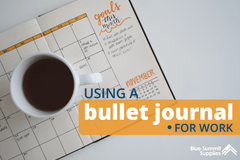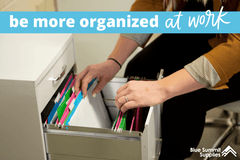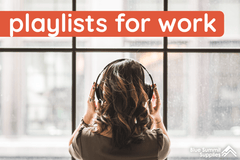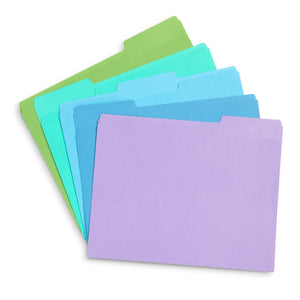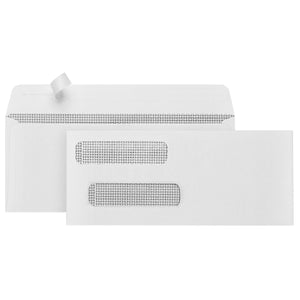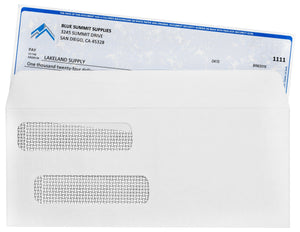The layout of an office is something you wouldn’t expect to be so important, but is actually a vital aspect for a variety of reasons. Gone are the days where merely renting out an office space and throwing in some desks makes a sufficient workspace. Office layout, furniture, and colors all play a key role in the morale, productivity, and overall happiness of an office.
In this article, we highlight the importance of a well-organized office layout, why productivity depends on a great layout, and suggest a few small office layout ideas that are sure to increase productivity in your office.
The Importance of an Office Layout
An office room layout designed with your employees in mind is essential. Office layout is directly related to productivity and workplace effectiveness. Your office layout should be a place that invites your team to feel comfortable and encourages them to get their job done effectively.
Safety
When planning the layout of your office, safety should be one of the first aspects to consider. What exactly does this mean? Find the emergency exits and consult the emergency plans of the building and build your design around them.
It’s essential that desks and heavy equipment like printers or cabinets are not blocking any emergency exits or even blocking the most direct paths to those exits. The safety of your team members is important, and the layout of your office should make exiting the workspace intuitive for everyone.
Additionally, safety also includes leaving enough room between desks, printers, and other equipment so no one trips or falls. Make sure to include enough walking space between desks so there’s enough room for chairs and pedestrians.
Comfort
Another feature to consider is the comfort of your team members. The office is where your employees spend at least eight hours of their day, five days of the week. That’s a lot of time to spend in a single area.
The comfort quality of an office can affect the morale of each person who works there. Poor quality chairs, desks, lighting, equipment, and even breakrooms can lead to poor overall work done. If your colleagues constantly have headaches from poor lighting or aches from an uncomfortable chair, chances are they won’t be performing to their full capability.
It’s important to provide a comfortable atmosphere in the office so employees can devote their undivided attention to their work. When designing a workspace layout, make sure to consider little things that could improve comfort. Investing in nice chairsand a comfortable breakroom might seem like unnecessary expenses, but in the long run, these costs will likely up saving money by leading to happier employees and increased productivity.
Productivity
Employee productivity is the most obvious benefit to a good office layout. An office setup that encourages team members to do work and minimizes distractions also increases the effectiveness in the workplace.
Different jobs will require different types of layouts. An office where teamwork is important will benefit from a different design than an office where employees require isolation. Because every workplace is different, there are a variety of office types that could be effective, including open and closed style layouts.
Open vs. Closed Layout Style
While there are many ways to design an office, there are two primary types of layout categories: an open layout and a closed layout.
Open Layout
Open office layouts have become extremely popular and for a good reason. Teamwork and communication are effortless with an open layout, since it encourages collaboration.
Many office layout designers will push for an open layout because they look sleek and modern. Open layout offices look great and bring with them room for energy to grow and ideas to flow between team members.
We have an open-office layout here at Blue Summit Supplies!
Open Layout Office Ideas
- Long tables where all employees can sit together.
- Sections of couches and chairs where employees can relax and collaborate in comfort.
- Tables and areas sectioned by whiteboards for spontaneous creativity and brainstorming.
- Desks placed facing one another to encourage communication with coworkers.
An open layout is something you should consider if your business requires teamwork and quick communication, and if putting employees close together could increase overall productivity. Most creative-type jobs such as marketing, publishing, and advertising embrace open layouts, as well as startups (like us!).
Closed Layout
Closed layouts, sometimes called private layouts, are a very classic office style. They’re great for jobs that require solo work and emphasize a quiet office with space to think.
Closed layouts are ideal for many office jobs where an open layout would decrease productivity. These layouts encourage a quiet office atmosphere so team members can concentrate, have phone calls, and work.

Ideas for closed layout offices
- Cubicles that provide quiet spaces and reduce distracting office noises and movement.
- Enclosed offices that provide maximum isolation for fewer distractions, phone calls, greater focus.
- Open-style floorplan but with walls between desks. This is a good option if you’re tight on space or funds for cubicles or private offices.
There are a lot of innovative ways to create a closed layout office. The important aspect to consider when making a privacy-optimized floorplan is to provide workspaces where your employees can work with minimal distractions.
A closed layout is something you should consider if your business is individually task-oriented rather than team-oriented. Many technical or engineering firms embrace the closed layout office, as well as accounting firms or sales agencies.
Office Layout Ideas
Now that we’ve discussed why it’s essential to choose the right office layout and the types of office layouts, let’s look at some ideas that you can incorporate into your own office, whether that’s a modern office, a small office, or even a home office.
When designing your office layout, think about how you can check off any safety, comfort, and productivity factors that will enhance your office. Then, decide on how your office size and type can best accommodate your employees and their needs.
Modern Office Layout
For your modern office, the layout could include both private and open styles; this will depend on the business. These layouts align closely with those of simple open style offices: public areas with tables and desks, wide spaces that encourage communication, and sleek workspaces.

Modern Office Layout Ideas
- Choosing a building with many windows that let natural light into the office.
- Light-colored walls with tinted accents.
- Inspiring, modern, or classic artwork.
- Thin lines used on table, desk, and chair legs.
- Wood as an accent touch or feature.
- Incorporating plantsinto common areas to clean the air, reduce carbon dioxide levels, and encourage creativity.
Office Color
Color is also very important in a modern office layout. Think bright and inviting areas. The best colors for office productivity include white and soft colors: yellow, soft orange, teal, and other soft shades of primary and secondary colors.
Modern layouts commonly use neutral colors like black, white, and grey. These colors promote the idea of a ‘blank slate’ to be filled while in the workplace. Using neutral colors in the office also allows for a variety of accent colors to be incorporated subtly into the layout.

Working in an office with dreary colors like grey and brown can add to the dull atmosphere of an office and even affect productivity. Adding a pop of color into a workspace can be a great way to help employees feel happier and increase the quality of their work.
Small Office Layout
When planning your small office design layout, it’s important to consider the best way to balance work type and office size. There might not be enough space to include everything that your business and employees need, but there are ways to make any sized space optimal for productivity and morale.
Small offices can also be open or closed layouts. However, with less space, you might find that an open layout helps enhance the size by keeping the area less congested.

Small Office Layout Ideas:
- Consider an open layout to optimize a small area. Keeping workspaces open will help a small room feel larger.
- Use on-desk dividers and partitions: plants, desk panels, etc. If you want to include privacy for employees but don’t have space for cubicles, consider sticking with an open layout but creating separate workspaces by separating desk spaces.
- If cubicles are necessary, smaller-sized areas between cubes will provide employees with privacy to conduct phone calls, video chats, and a quiet place of their own.
Small office spaces work best with open layouts, but closed layouts can work, too. If your business calls for a quiet atmosphere, there are ways to incorporate privacy into an open layout style such as using on-desk divider panels.
Home Office Layout
We’ve mostly focused on traditional style offices so far, but the reality is that many people work from home. Designing your best home office can include several of the ideas already mentioned, just altered for your home.

Office Layout Ideas for Your Small Office
- Use neutral colors to create a sleek and modern look.
- Use soft colored accents to promote creative thinking.
- Use warm colors to keep the cozy feeling of home in your office.
- Optimize space with tall shelving.
- Incorporate a cozy chair (you’re more likely to work odd and long hours while working from home).
- Have a visually appealing backdrop behind your desk for any possible video chats or meetings.
- If possible, choose a room with many windows or a large window to allow natural light into your workspace.
One of the greatest advantages to having a home office is that you can fully customize your office depending on your own style, preferences, and needs. When designing your home office, consider what will promote productivity.
Best Home Office Setup for Productivity
Productivity is crucial when working from home where there are far more distractions than in a conventional office. It’s important to optimize your home office so it encourages you to get down to business when you’re in the room.
- Use a desk with a large workspace. It’ll provide you with more room to spread out books, notes, and sketches, and even allow you to upgrade your computer screen size.
- Pick a desk with drawers for keeping your projects and files organized and within arm’s reach for easy access throughout the day.
- Install extra and bright lighting in the room. Work hours vary when you work from home and you can wake up as late or as early as you want. For night owls, adding in extra light sources is a great way to make your workspace effective, even at two in the morning.
- If you have enough space, add a couch. When leaving your home office for short breaks to chill on the couch or the kitchen, the chances of getting distracted drastically increase. With your in-office couch, you can stay in your workspace for short breaks while keeping inspiration and motivation flowing with fewer distractions. Also, sometimes it’s just nice to work from a couch!

Whether you’re working from a traditional office, a small office, or from home, the layout of your workspace affects productivity. Factors such as color, workspace size, privacy, and lighting affect morale, creativity, and productivity. When looking for the best office layout ideas, there is no single or simple answer, but we hope these ideas have helped you narrow down your options.
For more information on office organization and inspiration, check out our blog. To see what we’re up to every day, find us on Twitter, Instagram, and Facebook. And, as always, feel free to send us an email – Larry loves to hear from you!
 For more informative articles about office supplies, subscribe to our email newsletter!
For more informative articles about office supplies, subscribe to our email newsletter!
Never fear, you won't begin receiving daily sales emails that belong in a spam folder. Instead, we promise a fun weekly roundup of our latest blog posts and great finds from across the web. And if you lose interest, it's always easy to unsubscribe with a single click.





